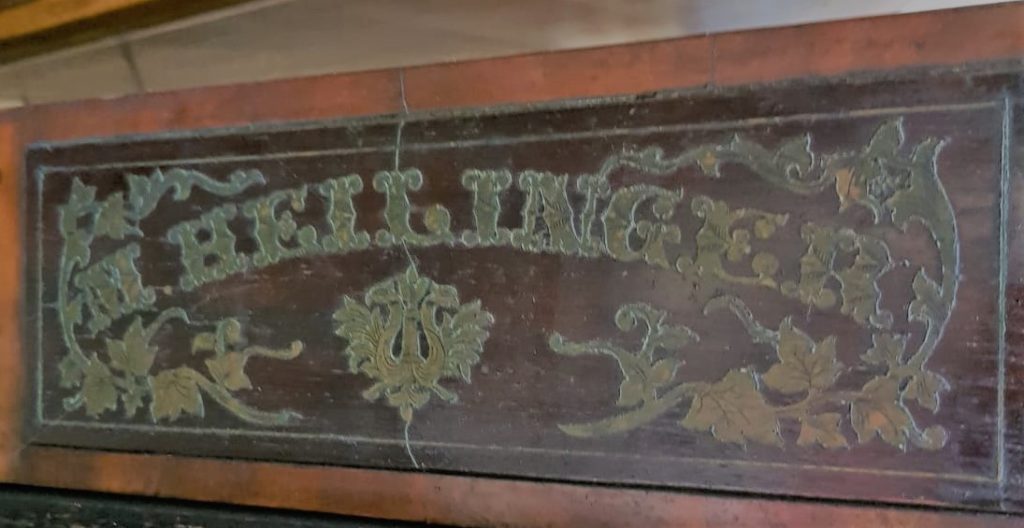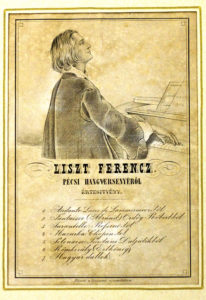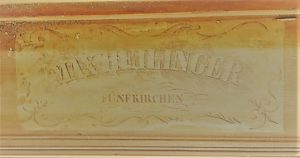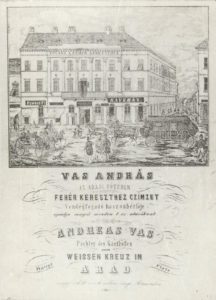Maximilian Heilinger 1832 – 1835
Description

| Date: | 1832 - 1835 |
| Origin: | Fünfkirchen (Pécs) - Hungary |
| Serialnumber: | --- |
Maximilian (Miksa) Heilinger is one of the Hungarian piano makers in the first half of the 19th century who were based in Fünfkirchen (Pécs). Little is known about him so far, but the fact that pianist and composer Franz Liszt (1811 – 1886) choose one of his instruments in 1846 for a concert makes this piano builder special.

Concert programm by Franz Liszt 25. Oktober 1846 in Pecs
This fortepiano was built around 1832 – 1835 and still shows the angular shape. It is made entirely of wood, without metal bars. The case is made of walnut and stands on three baluster legs. The keyboard is made of ivory and ebony and the hammers are covered with leather. It has a Viennese Action, is straight string with a divided bridge and two pedals (controlling dampers and una corda). The compass is 6 octaves + fifth (CC – g4). The nameboard is decorated with brass inlays and bears the inscription:
“M. Heilinger “
There is also a second signature that can be found on a decorated paper label on the soundboard:
“Max Heilinger
Fünfkirchen”

Maximilian Heilinger, Fünfkirchen c. 1832-35 (Soundboard Signature) – Eric Feller Collection
The entire fortepiano is made extremely precisely and shows a high level of craftsmanship.
So far, relatively little research has been carried out into piano building in Hungary in the 19th century and unfortunately there are only very few sources that have been examined. Due to the influence by the piano manufacturer in Vienna, piano construction in Hungary developed in a structurally similar way. Far fewer instruments were made, but most with a high standard of craftsmanship. The new developed pianoforte had established itself in Hungary since the 1790s and the demand for these instruments increased constantly. Despite the high acquisition costs and the resulting follow-up costs for tuning and repairs, the demand (especially from the aristocracy) was immensely high.
In the early years, instruments from Vienna served as prototypes and were copied by local carpenters and organ builders. From around 1810 onwards, the company’s own production of the instruments was hardly sufficient and so many pianos were imported and sold from Vienna. The explanations of the Hungarian piano maker Lajos Beregszászy (1817 – 1891) are an interesting source of this development in the first half of the 19th century.
„Von 1825 bis 1848 befanden sich in Ungarn fortwahrend 20-25 Klaviermacher und manche Firma arbeitete mit so vorzüglichem Erfolge, dass sie, angemessen der damaligen Zeit, mit welchem ausländischen Erzeugnis immer die Konkurrenz bestehen konnte. […] Im Jahre 1846 begann ich [Beregszászy] in Pest die Klavierfabrikation, 1847 Balassowits und Weiss; die beiden letzteren erzeugten bis 1848 jährlich 5-10 Klaviere. Aus diesen Daten ist also ersichtlich, dass bis 1848 in Ungarn ungefähr 20-25 Klavier-Fabrikanten existierten, die zusammen 250-300 Klaviere erzeugten und da den damaligen Verhältnissen entsprechend in Ungarn ein Bedarf von 600 Klavieren bestand, so war die Hälfte mit heimischen Erzeugnissen gedeckt, während heute, wo das Klavier so verbreitet ist, dass kaum eine Haushaltung ohne dasselbe existiert, und jährlich 1800 Stück kaum zur Deckung des Bedarfes genügen, – außer meiner Fabrik, in der jährlich 50-60 höchstens 70 erzeugt werden und außer dem Pressburger Karl Schmidt, der jährlich kaum 10-15 herstellt, kein Klavier-Fabrikant existiert und so ist kaum der zwanzigste Theil des Bedarfes durch heimische Produkte gedeckt“
From: L. Beregszászy, The Situation of Piano Manufacturing in Hungary. Budapest 1874. pp. 3 and 5-6.
The main cities of Hungarian piano building were Pest, Buda and Bratislava. In addition, instruments were also produced in other cities. Furthermore, the local manufactured instruments were cheaper to buy and without high transport costs and customs duties, as by imported instruments from Vienna. As a result more piano builders appeared in Hungary from the 1820s onwards. Many piano makers who settled in Hungary in the 1780s, 1790s and the beginning of the 19th century came from Germany.
So far, very little is known about Maximilian (Miksa) Heilinger. A letter kept in the archive of the Janus Pannonius Museum in Pécs shows that he worked in Pécs in 1832.
„Tekintetes Nemes Tanács!
1832-dik Évtől, ugy mint attól az időtől, hogy a Tekéntetes Tanács hozott végzése következtében megengedni kegyeskedett, hogy mesterségemet e nemes városban folytathassam – folytonos fáradozásom után csak ugyann sikerült, – hogy a zongorán, annak nagyobb és biztosabb tökéletessége elnyerésére új találmányomul hozzá járulok – és ezen új találmányomra á Nagy Méltóságú Magyar Királyi Helytartó Tanácshoz elnyerendő magányos kiváltság levél végett folyamodásomat béadandok – melly kiváltságlevél elnyerésére a többek között felmutatni szüksége*. hogy több évek olta számos legényekkel a tisztelt közönségnek tellyes megelégedésével mesterségemet folytattam – Hogy számos legényekkel évről évre dolgoztam, közönségessen tudva vagyon, de különben is az esztendei Popularis Conscriptio annak tanuja.
Továbbá, hogy a tisztelt Közönség tellyes megelégedésével az 1832 Évtől mesterségemet folytattam, ennek nyilvános tanúja az – hogy 15 évek alatt bár melly munkámért Tekéntetes Tanács elébe mint bépanaszolat nem idéztettem -.
Midőn Kegyes pártfogásért alázattal esedeznék a szükséges Bizonyítványt kiadattni kérem, megkülönböző tisztelettel maradván A Tekéntetes Nemes Tanácsnak
legalázatosabb szolgája Heilinger Miksa Zongora készítő“
From: Yearbook of the Janus Pannonius Museum Pécs, No. 32, 1987, published in 1988 Janus Pannonius Museum
It is still unclear where his workshop was located from 1832 to 1845. In 1845 he bought a warehouse at the Déryné Street 5 for 4,500 guilders from Anna and Borbála Bittó. In 1849, however, he sold the building again at a price of 4,000 guilders. (See: József Madas: Grundstücke und Häuser der Innenstadt von Pécs, Pécs, p. 101, 1918.) He probably left Pécs or moved again.

Fehér kereszt, Arad 1880
In November 1846 Franz Liszt played one of his instruments in the Hotel Weißes Kreuz (today Hotel Ardealul) in Arad. Only three other instruments from his workshop are known yet.
Other preserved fortepiano by Maximilian Heilinger:
- 18?? Fortepiano – Arad
- 18?? Fortepiano – Historical Museum of the City of Pécs, Hungary
- 1860/70 fortepiano – Hangszermúzeum (Museum of Musical Instruments), Budapest, Hungary
| Length: | 210 cm |
| Width: | 132 cm |
| Height: | 35 cm |
| Circumference: | 6 octaves + fifth (CC - g4). |
| Mechanics: | Viennese Action |
| Pedals: | 2 Pedals (dampers & una corda) |
| Signature: |
Nameboard: „M. Heilinger“ Soundboard: „Max Heilinger Fünfkirchen“ |

